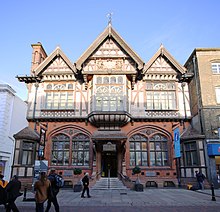Royal Museum and Art Gallery

The building from the front
|
|
| Established | 1899 Closed for refurbishment 2009−2012 |
|---|---|
| Location | 18 High Street, Canterbury, Kent CT1 2RA, England |
| Type | Museum, art gallery, library, regimental museum |
| Public transit access | Rail: Canterbury West; Canterbury East Buses: National Express; Stagecoach; Canterbury bus station |
| Website | Beaney House of Art and Knowledge |
The Beaney House of Art and Knowledge is the central museum, library and art gallery of the city of Canterbury, Kent, England. It is housed in a Grade II listed building. Until it closed for refurbishment in 2009, it was known as the Beaney Institute or the Royal Museum and Art Gallery. It reopened under its new name in September 2012. The building, museum and art gallery are owned and managed by Canterbury City Council; Kent County Council is the library authority. These authorities work in partnership with stakeholders and funders.
The Tudor Revival Beaney Institute building was designed by architect and City surveyor A.H. Campbell in 1897 and opened on 11 September 1899 at a cost of £15,000, after Dr James George Beaney left £10,000 to Canterbury for the institute, and Canterbury City Council added £5,000 so that Beaney's institute could accommodate the city's existing museum and library, which was transferred to the Beaney Institute building with the added name "Royal" in 1898. That existing museum and library had originated on Guildhall Street in 1825 as the Canterbury Philosophical and Literary Institution, been bought by the City in 1846 and was established as the Canterbury Museum and Public Library in 1858; the Guildhall Street building in Sun Yard now contains the local branch of Debenhams and bears a blue plaque. Beaney was a colourful character, whose professional life was beset by controversy with the Melbourne medical establishment. His bequest was left for "the erection and endowment of an institute for working men" in which his own portraits were to be hung in the main hall. Canterbury would have received another £60,000 from the residue of his will, however Beaney made up his differences with Melbourne and by the end of his life a codicil was added so that Melbourne received the £60,000.
...
Wikipedia
